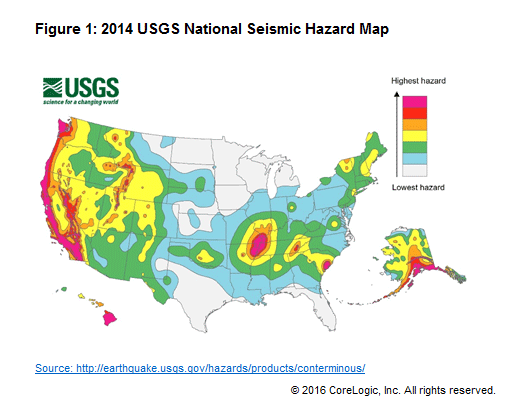Earthquakes may just be the Rodney Dangerfield of natural disasters. They get no respect relative to most other natural disasters--likely due to the infrequency of major quakes.
CoreLogic reminds us that wildfires are seemingly constant in the West; the Midwest rarely gets through a spring without at least one devastating tornado and every winter seems to bring a blizzard of the century and we are fresh off of hours of coverage of Hurricane Mathew and its massive floods. But absent the headline events, businesses and average citizens don't think of natural hazard risk on a daily basis.
So how long since people gave much thought to earthquakes? It has been more than 20 years since the U.S. has experienced a major damaging one; the Northridge (California) quake in 2004. The magnitude (M) 6.7 quake killed 72 and caused damage estimated between $20 and $25 billion.
MaiClaire Bolton of CoreLogic's insurance department writes in the company's blog that there have been a few reminders since Northridge; a M5.8 event in 2011 with an epicenter in Virginia that was felt over much of the eastern seaboard (and did substantial damage to the Washington Monument) and Napa, California's August 2014 M6.0 quake that caused some structural damage and impacted the wine industry. However, Bolton says, "None of these earthquakes have had the wide-spread catastrophic impact that previous historical earthquake events have, including the 1906 San Francisco or the 1811-1812 New Madrid earthquakes. Yet the potential is real and increasing daily."
There are, according to the United States Geological Survey (USGS), about 50 earthquakes a day throughout the world, about 20,000 a year. Only a small number cause any significant damage, but Bolton says "the risk of a major damaging earthquake in the U.S. should be a growing concern."
The thought of earthquake risks usually brings California to mind as the state has historically had the highest level of seismic hazard and has been the most seismically active region in the country. Bolton ticks off its history;
- 1989, Loma Prieta, M6.9. Collapsed part of the Oakland/San Francisco Bay Bridge
- Northbridge. Up until Hurricane Katrina the costliest natural disaster in U.S. history.
- 1906, the famous San Francisco Quake, M7.8
- 1868. Hayward Fault, M6.8
- 1857, Fort Tejon, M7.9.
With its high seismic hazard and large population - Los Angeles is the country's second largest city and San Francisco Bay the sixth largest metro area - California remains the highest at-risk region in the country but is by no means the only area with such risk.
The Pacific Northwest has a long history of damaging earthquakes and Bolton calls a potential M9.0 quake and tsunami along the Cascadia subduction zone "very likely." The Intermountain West region, has the Wasatch Fault which runs through Utah and Idaho in close proximity to Salt Lake City. The New Madrid region encompassing Missouri, Illinois, Indiana, Kentucky, Tennessee, Alabama, Mississippi and Arkansas, has a history of M7-8 quakes in the early 1800s close to Memphis and St. Louis.

The Northeast has a lower exposure to earthquake risk, but there is a seismic zone running along the St. Lawrence River basis. In the Southeast, Charleston, South Carolina experienced a devastating M7.0 earthquake in 1886.
The central U.S., especially Oklahoma and North Texas is a rising area of concern. The blog article points to a recent USGS study that shows Oklahoma has more earthquakes now than does California. This increase "is highly correlated with oil and gas exploration, specifically the injection of waste fluid, a byproduct of the hydraulic fracturing process."
This new hazard has been difficult to quantify, Bolton says, because the trend has been rapidly changing with more earthquakes year-over-year, something which does not fit with the historical record. The USGS has a new, independent, short-term study of earthquake hazard, specifically related to man-made or induced seismic activity, which presents the perception that the hazard in Oklahoma is the highest in the nation. "However, it is important to understand that the exposure to this hazard and the history of large damaging earthquakes is far less than that in California. As such, California remains the top-ranked state for overall earthquake risk."
Bolton said CoreLogic is launching a series of articles on earthquake risk that will investigate recent developments in the science and how it is changing the way earthquake risk is managed. The series will explore sequentially the risk in California, parts of the Pacific Northwest, New Madrid, and the emerging risk in Oklahoma.







